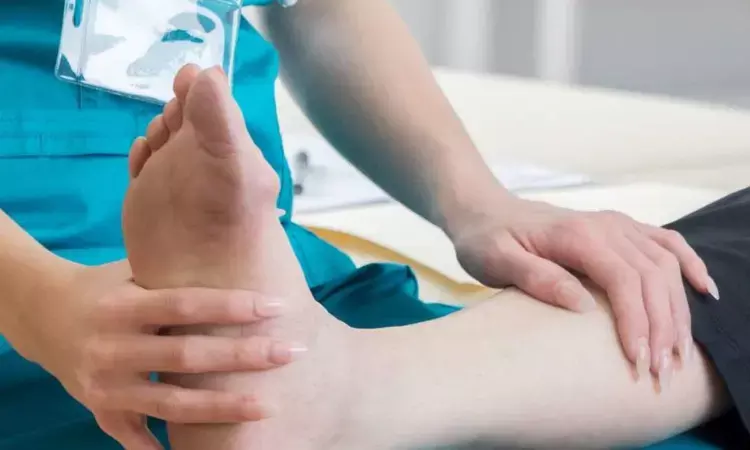- Home
- Medical news & Guidelines
- Anesthesiology
- Cardiology and CTVS
- Critical Care
- Dentistry
- Dermatology
- Diabetes and Endocrinology
- ENT
- Gastroenterology
- Medicine
- Nephrology
- Neurology
- Obstretics-Gynaecology
- Oncology
- Ophthalmology
- Orthopaedics
- Pediatrics-Neonatology
- Psychiatry
- Pulmonology
- Radiology
- Surgery
- Urology
- Laboratory Medicine
- Diet
- Nursing
- Paramedical
- Physiotherapy
- Health news
- Fact Check
- Bone Health Fact Check
- Brain Health Fact Check
- Cancer Related Fact Check
- Child Care Fact Check
- Dental and oral health fact check
- Diabetes and metabolic health fact check
- Diet and Nutrition Fact Check
- Eye and ENT Care Fact Check
- Fitness fact check
- Gut health fact check
- Heart health fact check
- Kidney health fact check
- Medical education fact check
- Men's health fact check
- Respiratory fact check
- Skin and hair care fact check
- Vaccine and Immunization fact check
- Women's health fact check
- AYUSH
- State News
- Andaman and Nicobar Islands
- Andhra Pradesh
- Arunachal Pradesh
- Assam
- Bihar
- Chandigarh
- Chattisgarh
- Dadra and Nagar Haveli
- Daman and Diu
- Delhi
- Goa
- Gujarat
- Haryana
- Himachal Pradesh
- Jammu & Kashmir
- Jharkhand
- Karnataka
- Kerala
- Ladakh
- Lakshadweep
- Madhya Pradesh
- Maharashtra
- Manipur
- Meghalaya
- Mizoram
- Nagaland
- Odisha
- Puducherry
- Punjab
- Rajasthan
- Sikkim
- Tamil Nadu
- Telangana
- Tripura
- Uttar Pradesh
- Uttrakhand
- West Bengal
- Medical Education
- Industry
Smoking, high BP and diabetes independently linked to peripheral vascular disease, suggests study

A new study published in the journal of Cureus showed that smoking, diabetes, and high blood pressure are independent risk factors for peripheral vascular disease (PVD) in Northeast India that are specific to a certain location.
Peripheral arterial disease (PAD) is the subject of this study because of its increased rates of morbidity and mortality associated with cardiovascular fatalities. The majority of research on PVD risk factors comes from Western nations, with little information accessible in developing nations like India. This study was set to examine the different risk factors most frequently linked to peripheral vascular disease in a northeastern Indian tertiary care hospital because there is a severe paucity of data on PVD in this area.
Finding risk variables in patients with PVD was the goal of this hospital-based case-control research, which was carried out in both retrospective and prospective modalities. From January 2015 to January 2025, a tertiary care teaching hospital in Northeast India served as the study's site. Group A consisted of individuals with PVD, while Group B consisted of healthy volunteers who did not have PVD.
The study examined the course of the disease and the results of treatment over a ten-year period (January 2015–January 2025). It included prospective data (October 2020–January 2025) from a questionnaire survey and follow-ups, as well as retrospective data (January 2015–October 2020) from hospital records.
A total of 688 controls and 172 cases, at a 1:4 ratio, took part in the study. When compared to controls, cases had considerably higher rates of hypertension, diabetes mellitus, smoking history, and cardiac conditions. Peripheral vascular disease was substantially correlated with smokers' daily cigarette consumption and smoking duration. The risk of peripheral vascular disease was considerably raised when smoking was coupled with diabetes mellitus and hypertension.
The most prevalent vascular pathology was atherosclerosis below the aortic bifurcation, which was detected in 104 patients (60.47%), followed by thromboangiitis obliterans in 63 individuals (36.63%). Male gender, smoking history, daily cigarette use, diabetes mellitus, and hypertension were all found to be distinct risk factors for peripheral vascular disease using multivariate logistic regression analysis.
The most popular therapy was amputation, which was followed by rehabilitation. Amputation was avoided in 17 of the 21 patients who tried bone marrow cell treatment. Overall, in Northeast India, smoking, diabetes, and alcohol use were found to be independent risk factors for PVD that were specific to a given location.
Source:
Hajong, R., Rabha, P., Medhi, B. B., Sharma, S., Pai, P. S., Baruah, A. J., & Devi, K. M. (2025). A retrospective risk-factor analysis of patients presenting with peripheral vascular disease in a tertiary care hospital in North-East India. Cureus. https://doi.org/10.7759/cureus.82661
Neuroscience Masters graduate
Jacinthlyn Sylvia, a Neuroscience Master's graduate from Chennai has worked extensively in deciphering the neurobiology of cognition and motor control in aging. She also has spread-out exposure to Neurosurgery from her Bachelor’s. She is currently involved in active Neuro-Oncology research. She is an upcoming neuroscientist with a fiery passion for writing. Her news cover at Medical Dialogues feature recent discoveries and updates from the healthcare and biomedical research fields. She can be reached at editorial@medicaldialogues.in
Dr Kamal Kant Kohli-MBBS, DTCD- a chest specialist with more than 30 years of practice and a flair for writing clinical articles, Dr Kamal Kant Kohli joined Medical Dialogues as a Chief Editor of Medical News. Besides writing articles, as an editor, he proofreads and verifies all the medical content published on Medical Dialogues including those coming from journals, studies,medical conferences,guidelines etc. Email: drkohli@medicaldialogues.in. Contact no. 011-43720751


